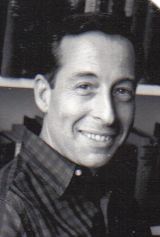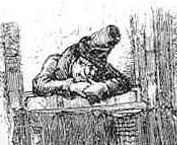 |
Sheldon Kranz Aesthetic Realism Consultant, Writer, Poet (1919-1980) |
|
Turning
Over a New Leaf; or, What Is Literature? By
Sheldon Kranz
Presented
October 19, 1974, at the Aesthetic Realism Foundation, 141 Greene
Street, New York City
7.
Dickens and Henry James
One of the earliest things I remember Eli Siegel telling his class was: "A person wants to be excited and he wants to be calm. When a person reads a book or looks at a picture or listens to music, he wants the same thing--he wants to be stimulated and he wants to be soothed at the same time." And if we look at the literature of the world, we find that wherever a poem or prose work gives true pleasure it puts together the opposites of energy and grace, excitement and calm. However, as in life, writers accent different things. For example, a poet like Gerard Manley Hopkins accents energy and roughness, as in these lines: All things counter,
original, spare, strange;
Whatever is fickle, freckled (who knows how?) A poet like Tennyson accents smoothness and repose as in these lines: Here are cool mosses
deep,
And through the moss the ivies creep, And in the stream the long-leaved flowers weep, And from the craggy ledge the poppy hangs in sleep. Novelists like Tolstoy and Victor Hugo represent energy of a tremendous kind. Henry James, in his novels, represents something quieter, something more restrained and graceful. But clearly, if Henry James were just graceful, a novel like Daisy Miller would be limp and spineless. Henry James has energy, but it is different from the energy of, say, Balzac, and it is not the first thing one feels. For example, take these two sentences from Henry James's The Tragic Muse: The great church was
still open, and he turned into it and wandered a
little in the twilight, which had gathered earlier there. The
whole structure, with its immensity of height and distance, seemed to
rest on tremendous facts--facts of achievement and endurance--and the
huge Norman pillars to loom through the dimness like ghosts of heroes.
Here we feel perception as graceful and thoughtful. We have a great church in twilight resting on facts; we have huge stone pillars looming like ghosts in the dimness. These are not the kinds of metaphors Tolstoy would use. He is too busy having his characters move about briskly. For example, from chapter one of War and Peace there is this: Anna Pavlovna's
drawing room gradually began to fill. The people
of the highest distinction in Petersburg were there, people very
different in age and characters, but alike in the set in which they
moved. The daughter of Prince Vassily, the beauty, Ellen, came to
fetch her father and go with him to the ambassador's fete.
It takes Henry James a page to say less. The James tempo is slower, quieter. For instance, here is James describing Isabel Archer in Portrait of a Lady: She had been looking
round her again--at the lawn, the great trees, the
reedy, silvery Thames, the beautiful old house; and while engaged in
this survey, she had made room in it for her companions; a
comprehensiveness of observation easily conceivable on the part of a
young woman who was evidently both intelligent and excited.
Henry James people are so engrossed in taking in what is around them, in understanding their feelings and the feelings of the person they are talking to, that they must take their time. It is part of the beauty of Henry James's world: the meditative grace with depth. Eli Siegel puts it this way in one of the poems from his James and the Children: A Consideration of Henry James's The Turn of the Screw [Definition Press, NY]. The poem is called "Rapidity Spoils Essence": According to H.J.,
It should take years to say You like somebody; Otherwise you are impetuous. But in the graceful depth and perception of Henry James, there is energy. It is the energy of thought, delicately finding its way. The James energy is in his perception of nuances of feelings, subtleties of mind. This, too, is power. A novelist who is clearly energetic and who belongs with Hugo, Tolstoy, and Balzac among the great creative energies of the world, is Charles Dickens. He is the person who tells us that nothing is dull, nothing is without its color and speed, nothing is more wonderful than life itself, even when it is shabby or ugly, or ridiculous or mean. The Dickens energy created hundreds of characters, and a world that is alive. Dickens loved the ludicrous and the uproarious. He loved the cozy and the domestic. He loved the pathetic. He loved London streets late at night, and stagecoaches in motion, loaded with passengers and luggage. He loved inns with roaring fires and glowing tables heaped with food; sinister attic rooms and graveyards and dingy law offices. And most of all he loved people-all kinds of people with their pretensions and uncertainties, and also their courage and kindness. The Dickens energy makes one like this world as much as anything can. It is, as Eli Siegel has said, good will as power. And it is in his very first novel, The Pickwick Papers. Dickens' style is to put things in motion, even things we ordinarily would not see that way. For example, take this sentence that describes a woman fainting. Dickens frequently has women fainting with hilarious effect. Fainting is customarily seen as a graceful, curving occurrence, as a woman sinks to the floor in a slow swoon. Dickens turns it into something like gymnastics, with three separate parts. The
spinster aunt uttered a piercing scream, burst into an hysteric
laugh, and fell backwards in the arms of her nieces.
That is slapstick and some of the most energetic fainting in literature. Evil also is shown to be tremendously energetic when Dickens describes it. One of his villains is the hideous little dwarf, Quilp, in The Old Curiosity Shop.  This is
Quilp eating in the presence of his wife and mother-in-law. This is
Quilp eating in the presence of his wife and mother-in-law.Here he by no means
diminished the impression he had just produced for he ate hard eggs,
shell and all, devoured gigantic prawns with the heads and tails on,
chewed tobacco and water-cresses at the same time, and with
extraordinary greediness, drank boiling tea without winking, bit his
fork and spoon until they bent again, and in short performed so many
horrifying and uncommon acts that the women were nearly frightened out
of their wits, and began to doubt if he were really a human creature.
That is all one sentence, and it sounds very different from a Henry James sentence. This has speed and energy. It does not wind. And the verbs give the sentence great motion: Quilp ate, devoured, chewed, drank, bit, performed. Eating, like fainting, becomes a kind of gymnastic. And here is a final example of Dickens' energy. It is a lovely sentence, while it is funny. It is also made up of separate parts, as a Dickens' sentence often is, to make for a certain speedy effect. This is very early in David Copperfield. Betsy Trotwood, a great-aunt, has been waiting for Mrs. Copperfield to give birth. Miss Trotwood is sure it will be a girl, whom, she declares, she will help raise. Then, mild Dr. Chillip tells her it is a boy. Dickens writes: My aunt never said a
word, but took her bonnet by the strings, in the manner of a sling,
aimed a blow at Mr. Chillip's head with it, put it on bent, walked out,
and never came back.
It should be seen that with all
the energy Dickens displays, his sentences are well-made, well-shaped,
artfully constructed. It is this shapeliness that gives them
repose. Dickens, as a person, also had an enormous driving
energy. But it was often a source of pain to him. It drove
him, sleepless, into the London streets to walk half the night.
It drove him to take on editing various periodicals and to become
intensely involved in amateur theatricals, even as he wrote his
novels. It drove him to travel; and in the end it drove him to
come to America to give exhausting readings from his works which
affected his health and shortened his life. That energy never
found a home, never found the quiet shape it had in the sentences in
his novels repose of a good sentence, even as it burst with energy, was
what Dickens looked for as a person, all his life. Charles Dickens is
one person I wish could have known Aesthetic Realism and Eli Siegel,
and through them, learned about the opposites.
Conclusion:
Liking the World
Aesthetic Realism explains that the beauty of a piece of literature and our enjoyment of it arise centrally from the way the opposites in reality are made one in it. The way literature resolves the warring opposites of, say, grace and energy, or freedom and order, or simplicity and complexity, is the answer to how to make sense of these same opposites in ourselves. That is why the study of Aesthetic Realism can have people care for literature in a new and authentic way, a way their lives will be better for. The magnificent coherence of Eli Siegel's showing how reality, literature, and ourselves all arise from one basis, has simply never been seen before. It is why his criticism is so accurate and beautiful--why he can say things about Henry James's The Turn of the Screw, or Shakespeare's sonnets, or a novel like Madame Bovary that have never been said before. In his criticism, literature and actual life join hands effortlessly. We feel that is how it really is, and we are more coherent seeing it. I love him and Aesthetic Realism for showing how we can use the prose and poetry of any time or place to like the world itself. |
|
Copyright 2006 SheldonKranz.com